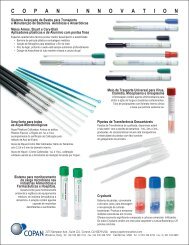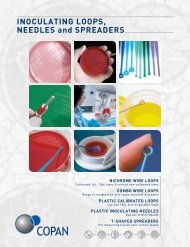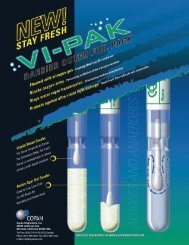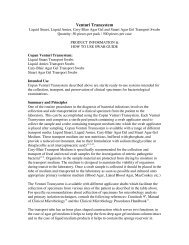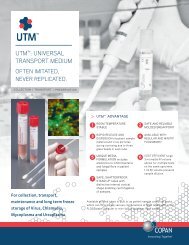Copan Universal Transport Medium (UTM-RT) - Copan Diagnostics
Copan Universal Transport Medium (UTM-RT) - Copan Diagnostics
Copan Universal Transport Medium (UTM-RT) - Copan Diagnostics
Create successful ePaper yourself
Turn your PDF publications into a flip-book with our unique Google optimized e-Paper software.
Specimens should be collected as soon as possible after the clinical onset of disease. Highest viral titers are present during the<br />
acute illness.<br />
For <strong>UTM</strong>-<strong>RT</strong> <strong>Medium</strong> Tubes<br />
1. Aseptically remove cap from tube<br />
2. Aseptically place vesicle aspirates, corneal or conjunctival scrapings, small pieces of tissue or stool samples into the tube with<br />
<strong>UTM</strong>-<strong>RT</strong> medium<br />
3. Replace cap to tube and close tightly<br />
4. Label with appropriate patient information<br />
5. Send to the laboratory for immediate analysis<br />
For <strong>UTM</strong>-<strong>RT</strong> Collection Kits<br />
1. Collect specimen with swab 5. Replace cap to tube and close tightly<br />
2. Aseptically remove cap from tube 6 Label with appropriate patient information<br />
3. Insert swab into the tube with <strong>UTM</strong>-<strong>RT</strong> medium 7. Send to the laboratory for immediate analysis<br />
4. Break swab shaft by bending it against the tube wall. For<br />
Minitip swabs, break shaft evenly at the pre-scored line.<br />
QUALITY CONTROL<br />
All lot numbers of the <strong>UTM</strong>-<strong>RT</strong> medium are tested for microbial contamination, toxicity to host cells and the ability to maintain<br />
viability of desired agents. Procedures for quality control of <strong>UTM</strong>-<strong>RT</strong> transport medium and virus culture media are described in a<br />
number of publications by the American Society for Microbiology 3,7,10 and by NCCLS 5,6 . If aberrant quality control results are noted,<br />
patient results should not be reported.<br />
LIMITATIONS<br />
1. Specimens should be handled aseptically.<br />
2. Condition, timing, and volume of specimen collected for culture are significant variables in obtaining reliable culture results.<br />
Follow recommended guidelines for specimen collection. 1,2,3,4,7,10<br />
3. Repeated freezing and thawing of specimens may reduce the recovery of viable organisms.<br />
4. <strong>UTM</strong>-<strong>RT</strong> is intended for use as a collection and transport medium for viral, chlamydial, mycoplasma and ureaplasma agents<br />
only. This medium can serve as a cryoprotectant for clinical viruses, including Cytomegalovirus and Varicella Zoster Virus.<br />
5. Because calcium alginate swabs are toxic for many enveloped viruses and may interfere with fluorescent antibody tests, they<br />
should not be used for specimen collection. Wooden shaft swabs may contain toxins and formaldehydes and should not be<br />
used. Polyester (Dacron) tipped swabs and Flocked Swabs are suitable when specimen collection by a swab is appropriate.<br />
6. <strong>UTM</strong>-<strong>RT</strong> kits are intended to be used with the medium tubes and swabs provided in the kit. The use of tubes of medium or swabs from<br />
any other source could affect the performance of the product.<br />
WARNINGS<br />
• Do not re-sterilize unused swabs.<br />
• Do not re-pack<br />
• Not suitable to collect and transport microorganisms other than viruses, chlamydiae, mycoplasma and ureaplasma<br />
• Not suitable for any other application than intended use<br />
• The use of this product in association with a rapid diagnostic kit or with diagnostic instrumentation should be previously<br />
validated by the user<br />
• Do not use if the swab is visibly damaged (i.e., if the swab tip is broken)<br />
• Applicator swab is qualified as Class IIa Medical Device according to European Medical Device Directive 93/42/EEC -<br />
Surgically Invasive Transient Use<br />
Class IIa means swabs can be used for sampling body surfaces, body orifices (e.g., nose, throat and vagina and deep invasive<br />
surgical wounds)<br />
• Do not ingest the medium<br />
• To be handled by trained personnel only<br />
• Do not use the <strong>UTM</strong>-<strong>RT</strong> medium for premoistening or prewetting the applicator swab prior to collecting the sample or for rinsing<br />
or irrigating the sampling sites<br />
RESULTS<br />
Results obtained will largely depend on proper and adequate specimen collection, as well as timely transport and processing in the<br />
laboratory.<br />
PERFORMANCE CHARACTERISTICS<br />
Viability studies were performed using <strong>Copan</strong> <strong>UTM</strong>-<strong>RT</strong> with a variety of viruses, chlamydiae, mycoplasma and ureaplasma. Swabs<br />
accompanying each transport system were directly inoculated in triplicate with 100µl of organismsm suspension. Swabs were then<br />
placed in their respective transport medium tubes and were held for 0, 24 and 48 hours at both 4°C and room temperature (20-<br />
25°C). At the appropriate time interval, each swab was vortexed, removed from its transport medium tube and then an aliquot of<br />
this suspension was inoculated into shell vials or into appropriate culture media. All cultures were processed by standard laboratory<br />
culture technique and examined after a specified incubation time. Organism viability was determined by fluorescing foci counts for<br />
viruses and chlamydia strains and by CFU counts for mycoplasma and ureaplasma strains.<br />
<strong>Copan</strong> <strong>Diagnostics</strong> Inc. December 14, 2004<br />
<strong>Copan</strong> <strong>UTM</strong>-<strong>RT</strong> System



